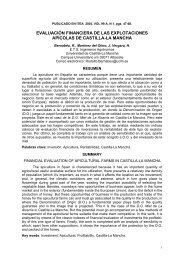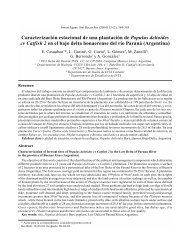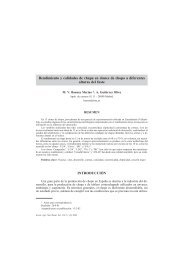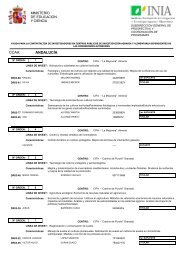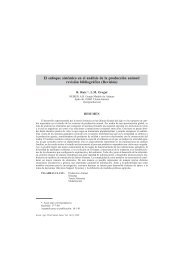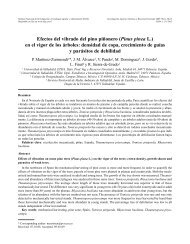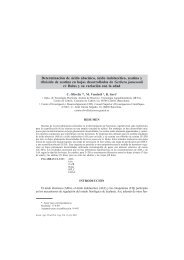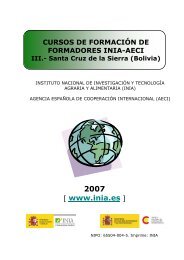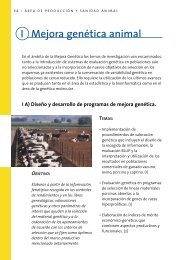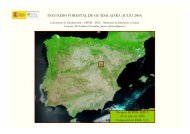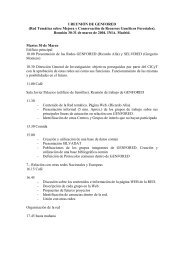Status of medicinal and aromatic plants in - Inia
Status of medicinal and aromatic plants in - Inia
Status of medicinal and aromatic plants in - Inia
Create successful ePaper yourself
Turn your PDF publications into a flip-book with our unique Google optimized e-Paper software.
88<br />
WORKING GROUP ON MEDICINAL AND AROMATIC PLANTS: FIRST MEETING<br />
Medic<strong>in</strong>al <strong>and</strong> <strong>aromatic</strong> <strong>plants</strong> <strong>in</strong> the Nordic Countries<br />
Katar<strong>in</strong>a Wedelsbäck Bladh<br />
Nordic Gene Bank (NGB), Alnarp, Sweden<br />
MAPs at the Nordic Gene Bank<br />
With<strong>in</strong> the Nordic countries the production <strong>and</strong> the collection <strong>of</strong> herbs <strong>and</strong> <strong>medic<strong>in</strong>al</strong> <strong>plants</strong><br />
is quite low. Dur<strong>in</strong>g recent years the <strong>in</strong>terest has <strong>in</strong>creased.<br />
In 1985, a work<strong>in</strong>g group for spices <strong>and</strong> <strong>medic<strong>in</strong>al</strong> <strong>plants</strong> was established at the Nordic<br />
Gene Bank. Among other work<strong>in</strong>g group activities, the group collected <strong>in</strong>formation <strong>in</strong> the<br />
area <strong>of</strong> <strong>medic<strong>in</strong>al</strong> <strong>and</strong> <strong>aromatic</strong> <strong>plants</strong> (MAPs). Only a few accessions <strong>of</strong> material where<br />
collected <strong>and</strong> conserved at the Nordic Gene Bank. Unfortunately, the group was closed<br />
down <strong>in</strong> 1993 due to lack <strong>of</strong> resources. Before it was closed down, the work<strong>in</strong>g group<br />
produced a study on Nordic <strong>medic<strong>in</strong>al</strong> <strong>plants</strong>, cover<strong>in</strong>g <strong>in</strong>formation such as content <strong>of</strong><br />
chemical substances <strong>in</strong> the <strong>plants</strong>, distribution, uses <strong>and</strong> recommendations for conservation.<br />
When the work<strong>in</strong>g group was closed down the material <strong>and</strong> the responsibility were carried<br />
over to the work<strong>in</strong>g group for vegetables. Table 1 lists the MAP species conserved at the<br />
Nordic Gene Bank.<br />
Table 1. MAP material stored at the Nordic Gene Bank (ACC = accepted; TEM = temporary)<br />
Species Denmark F<strong>in</strong>l<strong>and</strong> Icel<strong>and</strong> Norway Sweden<br />
ACC TEM ACC TEM ACC TEM ACC TEM ACC TEM<br />
Anthriscus cereifolium Chervil 2 1<br />
Carum carvi Caraway 1 3+3<br />
Angelica archangelica<br />
subsp. archangelica<br />
Angelica 1 1<br />
Levisticum <strong>of</strong>fic<strong>in</strong>ale Garden lovage 1<br />
Solanum nigrum<br />
Garden<br />
nightshade<br />
1<br />
Petrosel<strong>in</strong>um crispum<br />
var. crispum<br />
Parsley 11 7 2<br />
Anethum graveolens Dill 4 3 5<br />
Humulus lupulus Hops 19 10 31 32<br />
The SPIMED project<br />
However, dur<strong>in</strong>g the late 1990s <strong>in</strong>terest <strong>in</strong> this material <strong>in</strong>creased <strong>and</strong> <strong>in</strong> 2000 the work<strong>in</strong>g<br />
group for vegetables <strong>in</strong>itiated a project called SPIMED (SPIce <strong>and</strong> MEDic<strong>in</strong>al <strong>plants</strong>). It will<br />
run for five years (2001-2005) <strong>and</strong> is supported by the Nordic Gene Bank. The full title <strong>of</strong> the<br />
project is "Spice <strong>and</strong> <strong>medic<strong>in</strong>al</strong> <strong>plants</strong> <strong>in</strong> the Nordic <strong>and</strong> Baltic countries. Strategies for conservation<br />
<strong>of</strong> genetic resources <strong>in</strong> m<strong>in</strong>or crops". Its aim is to develop strategies for conserv<strong>in</strong>g cultivated<br />
spice <strong>and</strong> <strong>medic<strong>in</strong>al</strong> <strong>plants</strong> <strong>in</strong> situ or ex situ <strong>in</strong> the Nordic <strong>and</strong> Baltic countries. The three<br />
Baltic countries (Estonia, Latvia <strong>and</strong> Lithuania) are participat<strong>in</strong>g <strong>in</strong> the project as well as<br />
Norway, Denmark, F<strong>in</strong>l<strong>and</strong> <strong>and</strong> Sweden; <strong>in</strong> 2003, the project will exp<strong>and</strong> to <strong>in</strong>clude Icel<strong>and</strong>.<br />
Planned activities <strong>in</strong> the project are:<br />
1. To establish a priority list <strong>of</strong> species to be <strong>in</strong>cluded <strong>in</strong> the project; list exist<strong>in</strong>g <strong>in</strong> situ<br />
populations <strong>of</strong> these species;<br />
2. Consider if these populations are safe <strong>in</strong> terms <strong>of</strong> plant genetic resources conservation;<br />
3. Collect threatened species/populations for ex situ conservation;<br />
4. Develop descriptors for characterization <strong>of</strong> the species on the priority list;<br />
5. Characterize the collected material accord<strong>in</strong>g to these descriptors;<br />
6. Develop systems for documentation <strong>of</strong> <strong>in</strong> situ conservation;<br />
7. Map genetic variation <strong>in</strong> the species;<br />
8. Develop strategies for conservation, <strong>in</strong> situ or ex situ.




